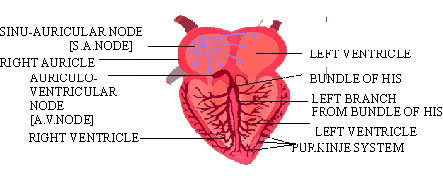|
PinkMonkey Online Study Guide-Biology
(C) Working of the Heart

Click here to enlarge
Figure 18.7 S.A. and A.V. node with conducting
or Purkinje fibers
i) The heart beat: The heart is a remarkable
organ. The heart beats continuously throughout an animalís life.
The heart contracts rhythmically, pumping a certain volume of blood
from each ventricle to different parts of the body. This volume
is called cardiac output.
The contraction of the heart is called systole
and the relaxation, diastole. The contraction and relaxation
of the heart forms a heart beat. The human heart beat can be heard
as "lub-dub" sound (heart sound) with a stethoscope. When
the body is at rest, the heart beats approximately 70 times per
minute, and each cardiac cycle lasts for about 0.8 seconds.
Functioning: (1) The cardiac cycle (heart
cycle) begins with atrial contraction (atrial systole), which is
initiated by electrical stimulus coming from the sino-atrial (S.A)
node, or "pacemaker". The stimulus is transmitted through
the atrio-ventricular (A.V.) node to bundle of His,
which spreads to form Purkinje fibers on the ventricle. (Fig. 18.7)
During atrial contraction, the blood from the atria is forced into
the respective ventricles. The bicuspid and tricuspid valves prevent
back flow of the blood.
(2) The ventricles now undergo powerful contraction
(ventricular systole), during which bicuspid and tricuspid valves
remain closed. When the ventricular blood pressure increases (systolic
pressure) to more than that in the aorta and pulmonary arteries
, the blood enters these arteries through the semilunar valves.
(3) When the blood enters the arteries, the ventricles
relax (ventricular diastole) and the pressure (diastolic pressure)
in them falls. Simultaneously the atria have relaxed (atrial diastole)
and the atria fill with blood again. The cardiac cycle continues
in this way.
Heart sounds: During ventricular systole,
simultaneous closure of atrio-ventricular valves makes the first
sound --"lub". The second sound -- "dub"- which
is higher-pitched, shorter and sharper, is caused by the simultaneous
closure of aortic and pulmonary valves. Extra heart sounds, called
murmurs or a "hiss" sound, occurs when blood leaks from
the artery back into the ventricle, usually because one of the valves
is defective. (In that case the rhythm would be: Lub-hiss-dub or
lub-dub-hiss.)
[next page]
|